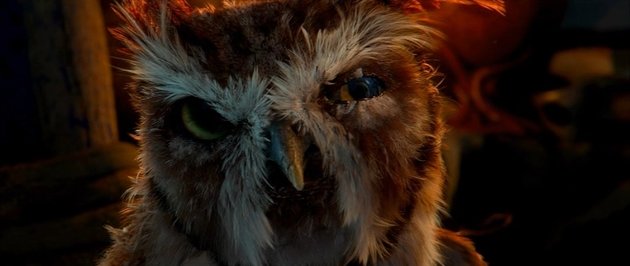Anxious parents fear their son will have a difficult life because of his facial deformity.
Legend of the Guardians

Based on the popular children’s book series Guardians of Ga’hoole, Legend of the Guardians: The Owls of Ga’hoole primarily revolves around fledgeling owl Soren, who is carried off by bigger, stronger owls when he falls to the forest floor one day. The owls call themselves the Pure Ones and are ruled by an owl with a facial disfigurement, Metal Beak, who wears an ornate metal helmet and mask to hide his missing beak. (It seems even the owl kingdom can’t escape the Disability Movie Cliche of the villain being hideously deformed to match the ugliness of his soul.)
The Pure Ones have an unusual tactic at their disposal; they mystically reduce their new young captives to a zombielike state using the power of the moon. “Moon blinked” owls appear as if blind from cataracts, and in a catatonic state until their masters order them to work in a mine of sorts; the moon blinked owls peck through regurgitated owl pellets to find flecks of magnetic material that the mice have eaten.
Soren escapes with the help of an older, disgruntled soldier, and finds his way to a giant hollow tree with new companions. The tree serves as base for the legendary Guardians that Soren’s parents have told stories about, and Soren is questioned by their leaders. One grizzled veteran owl speaks up for Soren, though later his new young friends joke that Ezylryb is “missing a few talons”, as code for not being “all there”.
Soren begins training to become a Guardian himself, and Ezylryb takes him under his wing. The eager young Soren is ready to charge off to battle to rescue his sister, but the wise Ezylryb dissuades him from entering the fray without proper training. “Well, this is what it looks like when you’ve actually fought in battle. Its not glorious, it’s not beautiful. And it’s not even heroic. It’s merely doing what’s right. And doing it again and again, even if someday you look like this.” he says, referring to his missing talons and blind eye.
Soren is dragged into battle anyway, and acquits himself nobly. Metal Beak is defeated, as symbolized by his empty mask. (The audience never actually sees his deformity, and how he’s able to speak intelligibly without a beak is never explained.)
The Last Rites of Ransom Pride
 The Last Rites Of Ransom Pride purports to be a Western, but looks more like an MTV music video starring Walker Texas Ranger. In it, a tough woman with the improbable name of Julliette Flowers lies, cheats, and kills in order to bring the body of her outlaw lover (with the even more improbable name of Ransom Pride) home to be buried next to his mother. In order to do this, she must exchange one life for another; namely, that of Ransom’s brother Champ. The blood-price is sought by one Bruja, a vicious Mexican voodoo priestess whose (Catholic?) priest brother was killed by Ransom some time before. And if you couldn’t tell Bruja was the villain from the decomposing headdresses she wears, she also has burn scars artfully disfiguring her face and eye.
The Last Rites Of Ransom Pride purports to be a Western, but looks more like an MTV music video starring Walker Texas Ranger. In it, a tough woman with the improbable name of Julliette Flowers lies, cheats, and kills in order to bring the body of her outlaw lover (with the even more improbable name of Ransom Pride) home to be buried next to his mother. In order to do this, she must exchange one life for another; namely, that of Ransom’s brother Champ. The blood-price is sought by one Bruja, a vicious Mexican voodoo priestess whose (Catholic?) priest brother was killed by Ransom some time before. And if you couldn’t tell Bruja was the villain from the decomposing headdresses she wears, she also has burn scars artfully disfiguring her face and eye.
Juliette Flowers and Champ Pride (am I the only one reminded of Hiro Protagonist?) embark on an almost hallucinogenic journey to retrieve Ransom’s body and gun down anyone in their way, encountering mythical creatures such as a dwarf and a pair of dying conjoined twins. The unnamed Dwarf and the token alcoholic black man get into a game of one-upmanship over who has the better life, but fortunately both are killed before the tales get really tall. The enigmatic twins seem to do nothing but lament their impending double demise.
Oh, and there’s a gratuitous deaf girl with crutch-using father who seems to serve no purpose other than to indicate how bad the bad guys are for abusing her.
Blurred and color-shifted imagery, millisecond flashbacks, and jarring camera work all contribute to the feeling that these disability tropes are, to paraphrase the conjoined twins, “performed for illiterate imbeciles and pathetic whores and they mock us”. We cannot allow this precious time we have to be stained with ridicule, indeed.
The Girl Who Played with Fire
 The Girl Who Played With Fire, the second in the trilogy of movie adaptions of the bestselling Stieg Larsson’s Millennium Trilogy (The Girl with the Dragon Tattoo, The Girl Who Played with Fire, The Girl Who Kicked the Hornet’s Nest) includes brief depictions of a man disfigured and crippled by burn injuries and age, and a person with congenital analgesia (an inability to feel pain).
The Girl Who Played With Fire, the second in the trilogy of movie adaptions of the bestselling Stieg Larsson’s Millennium Trilogy (The Girl with the Dragon Tattoo, The Girl Who Played with Fire, The Girl Who Kicked the Hornet’s Nest) includes brief depictions of a man disfigured and crippled by burn injuries and age, and a person with congenital analgesia (an inability to feel pain).
Using disfigurement as a shorthand of indicating a villain is a time-honored tradition in movies and literature before that, but at least in this case the villain arrived by his injuries as a result of his villainy; he was set afire by the plucky heroine as revenge for raping and beating her mother. Years later, when his name, Zalachenko, comes up in connection to a series of murders, the police dismiss him as a suspect because he’s a “cripple who would need to call a mobility service to get anywhere”.
Little do the police know that Zalachenko has a grown son, Niedermann, with congenital analgesia. Built like a tank and capable of carrying out Zalachenko’s dirty work; murders, intimidations, beatings, and torchings. People with an inability to feel pain have become the new cliche movie henchmen; they are portrayed as being virtually unstoppable and unmoved by the suffering of others. The reality for people with congenital insensitivity to pain is quite different. As they cannot feel the damage being done to their bodies minor injuries often escalate into permanent damage, leaving many of them unsuited to a life of crime.


